Basilica Co-cathedral Insigne collegiate church, Parish Church
The oldest and most important place of worship in the City of Sanremo.
A large number of historians, historiographers and enthusiasts have spoken about San Siro because it has always been the heart and centre of religious and civil life in Sanremo. We, who must obviously summarize and make the history of this monument accessible to everyone, have come across many versions of facts and events with dates that often do not coincide. To all these scholars, whom we will list at the bottom of this page, we would like to thank them for having shed light on a part of history, which together with others traces the history of our community and one of its symbols.
We, who must obviously summarize and make the history of this monument accessible to everyone, have come across many versions of facts and events with dates that often do not coincide. To all these scholars, whom we will list at the bottom of this page, we would like to thank them for having shed light on a part of history, which together with others traces the history of our community and one of its symbols.
It is a story that starts far, far away, confused between legend, oral tradition and reality.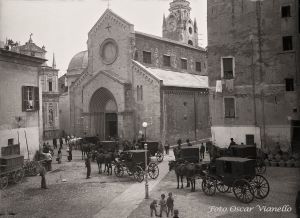 As we all know today Sanremo was inhabited since ancient times and the Romans founded a colony of rural villas and small settlements there. The Via Giulia Augusta (Aurelia) skirted the shores of the Mediterranean Sea pushing inland only to pass the various torrential streams of our territory. Every now and then during excavations traces of Roman colonization emerge or have
As we all know today Sanremo was inhabited since ancient times and the Romans founded a colony of rural villas and small settlements there. The Via Giulia Augusta (Aurelia) skirted the shores of the Mediterranean Sea pushing inland only to pass the various torrential streams of our territory. Every now and then during excavations traces of Roman colonization emerge or have 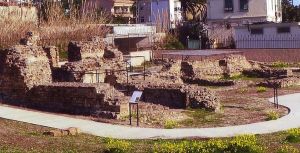 emerged and starting from the east we find: the villa of Bussana, the remains found in the (Roman Villa alla Foce) building of the access to the Armea municipal cemetery, the bridge in the locality of Rondò, the buildings of the Piano, the Capuchin necropolis, the Villa della Foce. All these traces and countless others that exist, form a Roman settlement called "Villa Matuziana or Matuciana" or even Matuzia. The gens Matucia family had given the name to the area that corresponds to the geographical territory that we can delimit between Capo Don, at the mouth of Argentina, and Capo Nero in ancient times Poipino. The existence of the great consular road Aurelia that connected Rome with Gaul and Iberia has always been a source of exchanges
emerged and starting from the east we find: the villa of Bussana, the remains found in the (Roman Villa alla Foce) building of the access to the Armea municipal cemetery, the bridge in the locality of Rondò, the buildings of the Piano, the Capuchin necropolis, the Villa della Foce. All these traces and countless others that exist, form a Roman settlement called "Villa Matuziana or Matuciana" or even Matuzia. The gens Matucia family had given the name to the area that corresponds to the geographical territory that we can delimit between Capo Don, at the mouth of Argentina, and Capo Nero in ancient times Poipino. The existence of the great consular road Aurelia that connected Rome with Gaul and Iberia has always been a source of exchanges 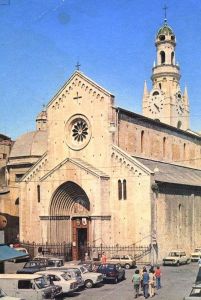
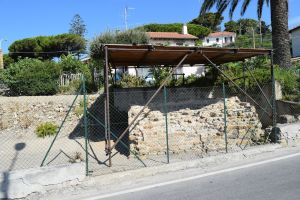 and transits of goods and people. As it skirted the mare nostrum in our territory, it ran along the current Corso Imperatrice, Via Corradi, Via Palazzo, Corso Garibaldi and Cavallotti. The Piano area, today's San Siro district, was particularly frequented during the imperial era, and it was here that the oldest memories and buildings of worship to pagan divinities were built.
and transits of goods and people. As it skirted the mare nostrum in our territory, it ran along the current Corso Imperatrice, Via Corradi, Via Palazzo, Corso Garibaldi and Cavallotti. The Piano area, today's San Siro district, was particularly frequented during the imperial era, and it was here that the oldest memories and buildings of worship to pagan divinities were built.
In 313 with the Edict of Milan, the Emperor Constantine granted freedom to Christian worship. Thanks to the emperor and his mother Helena, a grandiose programme of building great churches began in Rome. In some cases the imposing basilican buildings or pagan temples were used as places of worship in memory of the martyrs or saints. This made visible the Christian communities that until then had celebrated the Eucharist in absolute secrecy and in hiding, causing the progressive and rapid disappearance of the modest places of worship inside private homes. It is thought that this happened also in the ancient Villa Matuziana. In this historical period the figures of Ormisda, Siro, Romolo, the first bishops of Genoa and the Matuzians made the early Christian history of the City.
From the Arca tophea to the Protoromanesque building
Early Christian era - High Middle Ages
Jacopo da Varagine tells that Felice, one of the first bishops of Genoa, celebrated Mass assisted by the young deacon Siro. During the consecration a splendid light radiated on the altar and a heavenly vision appeared to the deacon.
Felice, fearing that the young man might be insuperable for the greatness of the miracle, took him away from Genoa and sent him to the Villa Matuziana in penance. Siro found himself proclaiming the Gospel with the holy priest Ormisda, who carried out the task of "corepiscopus", that is, the Vicar of Bishop Felice in this territory.
A few years went by and Ormisda, now an old man, died and was buried with the respect and honours due to a saint in the Arca tophea of the Villa Matuziana, the first small Christian church, probably built on a pagan altar, where he had prayed and celebrated the Eucharist. Siro, after having brought faith in Christ Jesus to the population of the Villa Matuziana, was elected bishop of Genoa. In his apostolate Siro distinguished himself for his holiness of life and for numerous miraculous interventions. In particular the exorcism on the daughter of the rich tax collector Gallione who lived in Tabja (Taggia) and the miracle of the snake (basilisk) driven out of the well. Siro ended his life in the odour of sanctity on 29 June of the year 381 (presumed) and was buried in Genoa.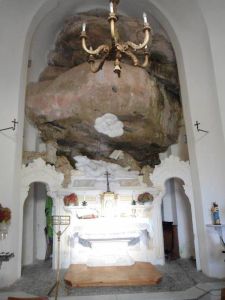 Romulus, who was born in the Villa Matuziana in the 4th century, was a bishop of Genoa who continued the evangelical proclamation of Ormisda and San Siro. Having to leave Genoa, probably because of the Aryan persecutions, he found refuge on the heights of the Villa Matuziana and on 13th October of an unspecified date in the 5th century he died after a life spent as shepherd of God's flock. The people moved the body of Bishop Romulus and buried it near Ormisda, in the Arca Tophea in the Piano district of the Villa Matuziana. In a document of the year 980, concerning a donation of tithes or income to the Canons of St. Siro, it is said that initially the body of bishop Romulus had been very decently preserved in a crypt still existing on the slopes of Monte Bignone, so that the whole area of the ancient Oppido Matuziano had taken the name of St. Romulus. According to tradition, in that place Ormisda, St. Siro and St. Romulus celebrated the Eucharist and administered the sacraments at different times. It therefore seems plausible that the Ark Tophea (the crypt mentioned in the document of 980) was in the primitive building of worship, a real baptismal parish church that had taken the name of San Siro by the will of the ecclesial community of the time. This early Christian Community was initially subject to the pastoral government of the Bishop of Milan (Ambrosian Rite) and later to that of Genoa.
Romulus, who was born in the Villa Matuziana in the 4th century, was a bishop of Genoa who continued the evangelical proclamation of Ormisda and San Siro. Having to leave Genoa, probably because of the Aryan persecutions, he found refuge on the heights of the Villa Matuziana and on 13th October of an unspecified date in the 5th century he died after a life spent as shepherd of God's flock. The people moved the body of Bishop Romulus and buried it near Ormisda, in the Arca Tophea in the Piano district of the Villa Matuziana. In a document of the year 980, concerning a donation of tithes or income to the Canons of St. Siro, it is said that initially the body of bishop Romulus had been very decently preserved in a crypt still existing on the slopes of Monte Bignone, so that the whole area of the ancient Oppido Matuziano had taken the name of St. Romulus. According to tradition, in that place Ormisda, St. Siro and St. Romulus celebrated the Eucharist and administered the sacraments at different times. It therefore seems plausible that the Ark Tophea (the crypt mentioned in the document of 980) was in the primitive building of worship, a real baptismal parish church that had taken the name of San Siro by the will of the ecclesial community of the time. This early Christian Community was initially subject to the pastoral government of the Bishop of Milan (Ambrosian Rite) and later to that of Genoa.
Over the years the ancient early Christian building of the Arca tophea was replaced in the 10th century by a larger Proto-Romanesque church. At the dawn of the communal era it was in need of restoration and was replaced with a new building that was larger and closer to the architectural styles of the time, a construction that we can see today.
From narrated history to documented history
The archaeological investigations in the underground of San Siro 1948 and 2019
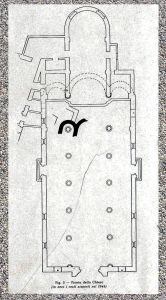 During the archaeological excavation in 1948 for the consolidation of the pillar supporting a quarter of the weight of the bell tower, the remains of the central and left
During the archaeological excavation in 1948 for the consolidation of the pillar supporting a quarter of the weight of the bell tower, the remains of the central and left 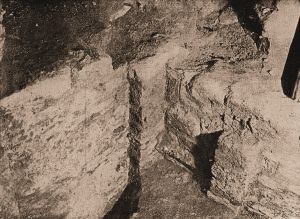 apse of the three-nave Proto-Romanesque church, aligned with the axis of the rectory and datable to the 11th century, were brought to light three metres deep from the current floor. It was possible to see and photographically document the pilasters that were supposed to support twin arches, datable around the year 1000. Inside the primitive church, a series of shaped semi-columns appeared on the east side, also of Romanesque type, covered with perfectly preserved stucco plaster. The remains of more ancient buildings were also found, with the remains of early medieval pesto earthenware floors, and large tiles and tiles of Roman tradition. All these findings suggest the existence of an early-
apse of the three-nave Proto-Romanesque church, aligned with the axis of the rectory and datable to the 11th century, were brought to light three metres deep from the current floor. It was possible to see and photographically document the pilasters that were supposed to support twin arches, datable around the year 1000. Inside the primitive church, a series of shaped semi-columns appeared on the east side, also of Romanesque type, covered with perfectly preserved stucco plaster. The remains of more ancient buildings were also found, with the remains of early medieval pesto earthenware floors, and large tiles and tiles of Roman tradition. All these findings suggest the existence of an early-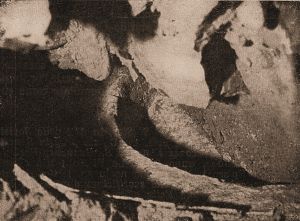 Christian church prior to the Proto-Romanesque one. Unfortunately all these archaeological evidences, after the ritual surveys, were hidden forever by a concrete casting that could never be touched again except by demolishing the bell tower.
Christian church prior to the Proto-Romanesque one. Unfortunately all these archaeological evidences, after the ritual surveys, were hidden forever by a concrete casting that could never be touched again except by demolishing the bell tower.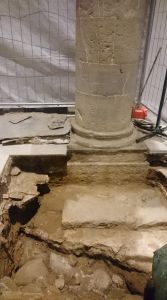 It would therefore be a basilica type church with three naves, built immediately after the Saracen devastation and at the dawn of the communal age. The Andalusian Saracens settled in Frassineto (near Saint Tropez on the Provencal Riviera) in 889 until their fall in 972. During this period the destruction of the Oppidum Matutianum and of the ancient early Christian baptismal parish church which had probably kept the remains of St. Romulus until the second half of the 9th century. Around 876, the Genoese bishop Sabatino ordered the transfer of the relics of St. Romulus to Genoa in order to preserve them from the increasingly frequent incursions into the far west of Liguria. When the Muslim danger was eradicated in 972, the population probably felt the need to build a new, larger and more beautiful place of worship.
It would therefore be a basilica type church with three naves, built immediately after the Saracen devastation and at the dawn of the communal age. The Andalusian Saracens settled in Frassineto (near Saint Tropez on the Provencal Riviera) in 889 until their fall in 972. During this period the destruction of the Oppidum Matutianum and of the ancient early Christian baptismal parish church which had probably kept the remains of St. Romulus until the second half of the 9th century. Around 876, the Genoese bishop Sabatino ordered the transfer of the relics of St. Romulus to Genoa in order to preserve them from the increasingly frequent incursions into the far west of Liguria. When the Muslim danger was eradicated in 972, the population probably felt the need to build a new, larger and more beautiful place of worship.
It is the protoromanesque building found in 1948 that was built with the nearby house of the Canons and the Baptistery of S. Giovanni Battista.
It is news of these last months that in the recent archaeological excavations (2018-2019) inside San Siro, preparatory interventions for the installation of a new pipe organ, other traces of this monument so linked to our most ancient Christian history have been found.
The XII-XIII century Romanesque Gothic building
The beautiful San Siro of today
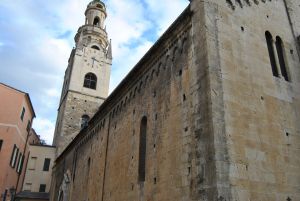 The sacred building was built in Romanesque Gothic style in a period of time ranging from the beginning of the 12th to the end of the 13th century.
The sacred building was built in Romanesque Gothic style in a period of time ranging from the beginning of the 12th to the end of the 13th century.
The first records attesting its existence are documents dating back to 1143 drawn up by the city council and a document dating back to 1254 kept in Genoa's State Archives (ASG carturale 52, notary Guido di San Ambrogio) explicitly attests the presence of a Blancus de Molzano magister antelami, who left power of attorney in order to collect what was owed to him on the occasion of laborerii et magisterii quod fecit in operi ecclesie Sancti Romuli. Therefore the duration of the worksite can be placed in the time span from 1143 to 1254.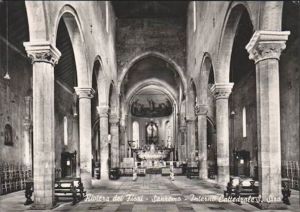 The church is built according to a general layout and execution technique similar to those that characterise in particular the cathedral of Albenga and the church of Saints James and Philip in Andora. The "magistri antelami" who were skilled bricklayers from Lombardy or Ticino participated in the construction of the church and at that time were employed on numerous building sites all over Liguria.
The church is built according to a general layout and execution technique similar to those that characterise in particular the cathedral of Albenga and the church of Saints James and Philip in Andora. The "magistri antelami" who were skilled bricklayers from Lombardy or Ticino participated in the construction of the church and at that time were employed on numerous building sites all over Liguria.
The church had a nave and two aisles divided by columns surmounted by pointed arches with three semicircular stone apses that bordered the temple to the east; the presbytery was in the area covered by stone vaults below the transept.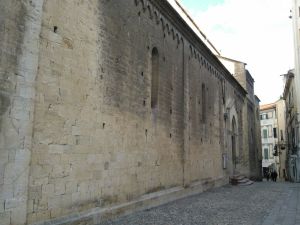 The whole building was built using a particularly compact limestone from the Verezzo quarry, while the slate roof of the naves was supported by a very hard wooden armour decorated with sacred subjects. Today the Co-Cathedral of San Siro is bordered by linear masonry, all in exposed stone and has three entrances, one in front and two on the sides.
The whole building was built using a particularly compact limestone from the Verezzo quarry, while the slate roof of the naves was supported by a very hard wooden armour decorated with sacred subjects. Today the Co-Cathedral of San Siro is bordered by linear masonry, all in exposed stone and has three entrances, one in front and two on the sides.
The interior with three naves is interspersed with six spans of circular section columns or polygonal section pillars, to which ogival arches are connected, with the roof of the side naves lower than the structure of the central nave. The sacred hall is illuminated by the large front oculus (rose window) and by a series of narrow side windows (7 single lancet windows and one mullioned window). The last span before the high altar is covered by a high cross vault.
The alternation of columns and pillars was determined by the choices of the various groups of workers who gradually worked in the church yard. Although the interior clearly appears to be Romanesque in style, there is also a general tendency of the whole towards the Gothic style.
 The characteristic façade features a cross-shaped window and the large rose window and part of two mullioned windows can still be traced back to the initial structure of the building dating back to the 13th century, and are not the result of the renovation carried out in 1902. The prothyrum or large ogival portal with splayed forepart, very similar to the one existing at the entrance to the cathedral of Ventimiglia, is clearly an addition to the original structure.
The characteristic façade features a cross-shaped window and the large rose window and part of two mullioned windows can still be traced back to the initial structure of the building dating back to the 13th century, and are not the result of the renovation carried out in 1902. The prothyrum or large ogival portal with splayed forepart, very similar to the one existing at the entrance to the cathedral of Ventimiglia, is clearly an addition to the original structure.
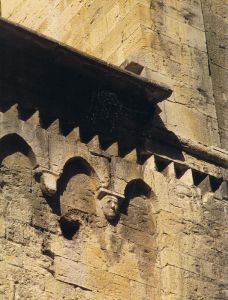

 The same door when there was a caper plant The portal on the right side, also called "of the caper" because of the plant that grew there, surmounted by a rare glabrous head in the round, has a sixteenth and seventeenth-century marble relief in the tympanum depicting the Virgin and Child Jesus and the saints Siro and Romolo from the church of San Mauro in Pian di Nave destroyed in 1754-1755 to build the fort of Santa Tecla.
The same door when there was a caper plant The portal on the right side, also called "of the caper" because of the plant that grew there, surmounted by a rare glabrous head in the round, has a sixteenth and seventeenth-century marble relief in the tympanum depicting the Virgin and Child Jesus and the saints Siro and Romolo from the church of San Mauro in Pian di Nave destroyed in 1754-1755 to build the fort of Santa Tecla.
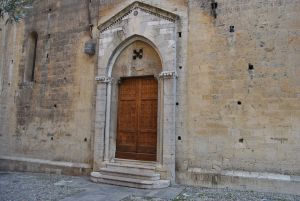
 The twin portal on the opposite side, perforated by a quadrilobed oculus, in the upper architrave and in the key of the cusp uses reuses, or presumed reuses, that show respectively a cruciferous quadruped passing between two palms and a Chrismon, ancient baptismal symbol of Ambrosian origin with eight rays between two heraldic figured peacocks.
The twin portal on the opposite side, perforated by a quadrilobed oculus, in the upper architrave and in the key of the cusp uses reuses, or presumed reuses, that show respectively a cruciferous quadruped passing between two palms and a Chrismon, ancient baptismal symbol of Ambrosian origin with eight rays between two heraldic figured peacocks.
By the way, it is worth remembering that this portal once allowed the passage of the faithful and clergy from the church to the baptistery, especially during the solemn baptismal liturgy on Easter night, and consequently the portal stands out with decorative baptismal apparatuses becoming a "baptismal door".
The precious wooden ceiling
A very rare example of painting on wood from the Middle Ages
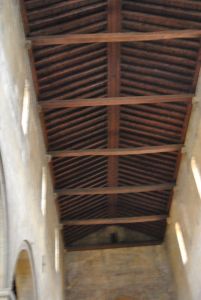 The decorated wooden roofThe roof of the church was supported by a typical truss construction that supported the roofing boards and slates. The magistrates The wooden roof today decorated the wooden ceiling with wooden coverings designed with ornamental motifs in bright colours and with small boards that carried symbols or figures painted on brown or dark red backgrounds. There were effigies of green angels with red lilies in their hands, white angels with black wings, mitered bishops with a palio in the act of blessing, lambs with a red and light red flag and haloes with red and light-coloured bands. The figure of the Easter lamb with a white flag with a red cross, which around 1259 had become Genoa's sign, confirms a date and a time: the completion of the works in the church of San Siro. From a small, almost insignificant detail, we can therefore confirm the date of construction of the building.
The decorated wooden roofThe roof of the church was supported by a typical truss construction that supported the roofing boards and slates. The magistrates The wooden roof today decorated the wooden ceiling with wooden coverings designed with ornamental motifs in bright colours and with small boards that carried symbols or figures painted on brown or dark red backgrounds. There were effigies of green angels with red lilies in their hands, white angels with black wings, mitered bishops with a palio in the act of blessing, lambs with a red and light red flag and haloes with red and light-coloured bands. The figure of the Easter lamb with a white flag with a red cross, which around 1259 had become Genoa's sign, confirms a date and a time: the completion of the works in the church of San Siro. From a small, almost insignificant detail, we can therefore confirm the date of construction of the building.
Of that roof of about two thousand square metres and almost 800 years old, there are still some pieces that were restored in 2017 by the Rotary of Sanremo by the restorer Bonifacio, and exhibited to the public. Another group of boards still remains to be restored and exhibited and it is hoped for adequate funding.
The apses
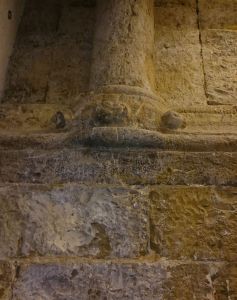 Romanesque-Gothic apse columnsBarely can we see any Romanesque-Gothic apses of the Co-cathedral, only a few small traces of the smaller ones at the end of the external side walls.
Romanesque-Gothic apse columnsBarely can we see any Romanesque-Gothic apses of the Co-cathedral, only a few small traces of the smaller ones at the end of the external side walls.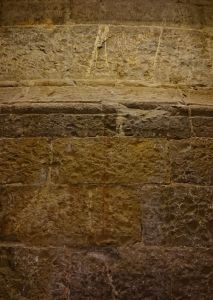
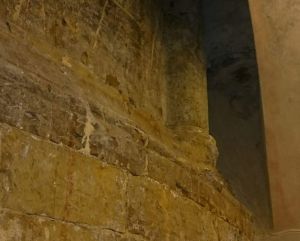 The main apse, on the other hand, has a history all its own. In 1997, thanks to a successful intervention in the religious articles shop underneath the presbytery of the Basilica, it was possible to recover and bring to everyone's sight the main apse which was covered with bricks and other materials from the middle of the 17th century. Part of the wall decoratedThe intervention strongly desired by Ernesto Porri, owner and founder of the II Campanile, was carried out under the guidance of the President of the Commission of Sacred Art of the Diocese of Ventimiglia - San Remo, Canon Angelo Nanni with the approval of the Superintendence of Artistic and Historical Heritage of Liguria in the person of the unforgettable Geom. Giuseppe Bellezza. This intervention of partial demolition of the Baroque superstructures made it possible to make visible the lower part of the apse which shows a fine decoration with semi-columns throughout its height.
The main apse, on the other hand, has a history all its own. In 1997, thanks to a successful intervention in the religious articles shop underneath the presbytery of the Basilica, it was possible to recover and bring to everyone's sight the main apse which was covered with bricks and other materials from the middle of the 17th century. Part of the wall decoratedThe intervention strongly desired by Ernesto Porri, owner and founder of the II Campanile, was carried out under the guidance of the President of the Commission of Sacred Art of the Diocese of Ventimiglia - San Remo, Canon Angelo Nanni with the approval of the Superintendence of Artistic and Historical Heritage of Liguria in the person of the unforgettable Geom. Giuseppe Bellezza. This intervention of partial demolition of the Baroque superstructures made it possible to make visible the lower part of the apse which shows a fine decoration with semi-columns throughout its height.
The Bell Tower
On the left side of the building stands the slender bell tower, in which three distinct building phases can be seen:
- the 13th century base, which is of the same manufacture as the whole church, and which in all probability was never finished;
- a fifteenth-century extension which denotes the use of freshly roughened stones and which reaches the level of the bell cell trampling;
- and a third phase that can be traced back to the Baroque period, which is the result of the rebuilding of the bell tower partially demolished by the Genoese up to the "clock chamber" as a punishment of the city after the revolution of 1753.
All the coeval Romanesque and Ligurian bell towers are not particularly high, they are a little higher than the highest part of the building, but they always have a beautiful spire which makes them optically taller. The demolition by the galleots of General Pinelli stopped more or less under the junction of the spire and therefore a large part of the Romanesque bell tower has survived until today. 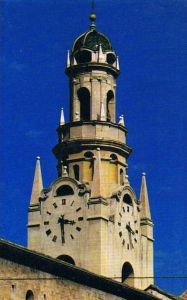
 Damaged during the last world war, it was rebuilt in the final part according to the baroque belfry, with a series of works completed in March 1948. The debate in Sanremo on the reconstruction was remarkable because some people would have welcomed the reconstruction of the bell tower in Romanesque-Gothic style as designed by Ing. Antonio Capponi, who at the beginning of the 20th century was the promoter of the great cycle of restoration. Another school of thought saw it inappropriate to build a fake and supported the rebuilding of the baroque bell tower, as the last generations of Sanremo have always seen. After heated discussions and diatribes, the City Council decided on reconstruction in the current baroque forms.
Damaged during the last world war, it was rebuilt in the final part according to the baroque belfry, with a series of works completed in March 1948. The debate in Sanremo on the reconstruction was remarkable because some people would have welcomed the reconstruction of the bell tower in Romanesque-Gothic style as designed by Ing. Antonio Capponi, who at the beginning of the 20th century was the promoter of the great cycle of restoration. Another school of thought saw it inappropriate to build a fake and supported the rebuilding of the baroque bell tower, as the last generations of Sanremo have always seen. After heated discussions and diatribes, the City Council decided on reconstruction in the current baroque forms.
The reconstruction was approximate and only in the first restoration in 1975 were all the details of the ancient bell tower, with spires and buds, recovered thanks to careful historical research using period photographs.
Prof.Nino Lamboglia with don Angelo Nanni took care of the intervention. In 2015 a new round of restorations gave back colour and beauty to the San Siro bell tower.
The Bells
- Il Campanone - first solo voice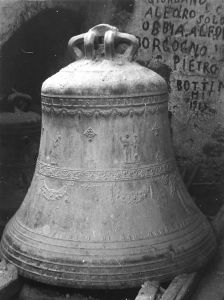 Weight about 2.000 Kg., dedicated to Saint John the Baptist, Patron Saint of Liguria.
Weight about 2.000 Kg., dedicated to Saint John the Baptist, Patron Saint of Liguria.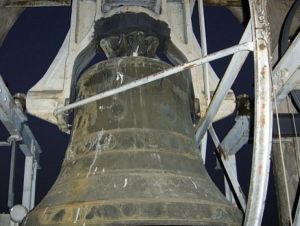 Motto: "Concilium voco, et solemnia festa decororo" (I summon the City Council and honour the solemn feasts).
Motto: "Concilium voco, et solemnia festa decororo" (I summon the City Council and honour the solemn feasts).
It is familiarly called "Bacì" by the old Sanremaschi people. In the central part of the bronze are depicted in relief: St. John the Baptist, the Immaculate Conception, the Blessed Virgin Mary Reginadel S.S.Rosario, the Syrian Saints, Romolo and Rocco. A sentence recalls that the Mayor of Sanremo in 1879 was Asquasciati. The motto admirably sums up the function that has always had the sound of the bell both in the civil and religious spheres.
"Bacì", in fact, with its serious and solemn chimes, summoned the town council to meetings, solemnized victories, triumphs and civil celebrations but also called the faithful to liturgical celebrations.
of the Solemnities. If civil service has gradually disappeared, religious service has remained: in fact, even today our Kiss continues to make its voice heard for the Solemnities of the Church and ecclesial events.
more important. For historical precision in the 50s of the last century the bell was still used to announce the meeting of the City Council.
- Angelus bell - second solo voice
Weight about 800 Kg., dedicated to the Virgin Mary; motto: "A fulgore et tempestate libera nos, Domine" (from the lightning and the storm liberaci, o Lord); depictions: the Cross, the B.V.Mary, St. Siro, St. Romolo and a rooster,
for it is the bell that greets the beginning and the end of the working day inviting to prayer and announcing the midday Angelus. In ancient times it was rung during big thunderstorms because it was thought that the sound
dispel the storm. It is the bell located in the highest part of the bell tower 40 metres above the ground: the lantern.
- Big bell - first bell
Shades: E flat, weight 940 kg, dedicated to Saint Romulus, patron saint of the city;
Motto: "Sancto Romulo, qui civitati huic nomen et praesidium tribuit auxilium donat" (to St. Romulus , who gives his name to this city, grant him protection, and give him help).
- Second Bell
Tonality F, weight 670 kg.; dedicated to the B.V.M. Queen of the Most Holy Rosary;
Motto: Reginae Sncratissimi "Rosarii advocate et distructus glorianter conclamatae die primo Septembrisanno" (to the Queen of the Most Holy Rosary, acclaimed, with all glory and honour, patroness on 1st September in the year 1731).
- Third bell
Tonality: Sol, weight 490 kg., dedicated to San Siro, owner of the Basilica;
Motto: "Sancto Syro, titulari Ecclesiae loci quoque patrono et defensore fortissimo" (to St. Syro, titular of the local church and also very powerful patron and protector).
- Fourth bell
Shades: B flat, weight 403 kg., dedicated to B.V.M. Help of Christians, Mother of the Church, Queen of the World;
Motto "Mariae Matri Ecclesiae, Mundique Reginae, in periculos cunctis auditrici" To Mary, Mother of the Church, and Queen of the World, auxiliary of all dangers).
- Fifth bell
Shades: B flat, weight 293 kg, dedicated to the Extraordinary Post-Conciliar Jubilee;
Motto: "Sacro extraordinario Iubileo Postconciliari - 1° Ianuarii anno MCXLXVI - 29 mai MC;LXVI" (to the Sacro Giubileo straordinario postconciliari - 1° January - 29 May 2966). The Extraordinary Jubilee was called
6 December 1965 for the closure of the Second Vatican Ecumenical Council.
- Sixth bell
Tonality: C, weight215 kg., dedicated to the Second Vatican Ecumenical Council, H.H.John XXIII a and H.H.Paul VI;
Motto: "Sacrosanto Concilio Ecumenico Vaticano Secundo et Ioanni XXIII Paoli VI - Die 11 Ooctobris anno MCMLXV" al sacrosanto Concilio Ecumenico Vaticano II a a a GiovanniXXII e Paolo Vi - 11 ottobre 1962 - 7 dicembre 1965).
- Seventh bell
Shades: King Flat, weight 179 kg, dedicated to the value of a new and holy vocation;
Motto "Mitte operarios in messem tuam" (Send workers to your mass!).
- Eighth bell
King shade, weight 159 kg., dedicated to the Guardian Angel;
Motto "Sanctis Angelis, qui vident semper faciem Patris, custodisusque nostris contra diabolicas fraudes" (to the Holy Angels, who always see the face of the Father, and our guardians, against the snares of the devil).
- Ninth bell
Tonality: E flat, weight 126 kg, dedicated to the purgative souls of all the faithful departed;
Motto: "Omnibum Fidelibus defunctis requiem".
- Tenth bell
Tonality: F, weight 97 kg, dedicated to the Blessed Virgin Mary Immaculate Conception;
Motto "Mariae Immacolatae".
Art in the Concatterale of San Siro
The numerous works that embellish the interior are linked to the different phases of the building's life.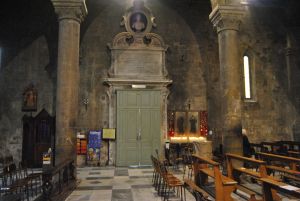 Above the left side entrance is the funeral monument with marble bust and plaque dedicated to the benefactor Giuseppe Morardo dating back to 1784. It is
Above the left side entrance is the funeral monument with marble bust and plaque dedicated to the benefactor Giuseppe Morardo dating back to 1784. It is 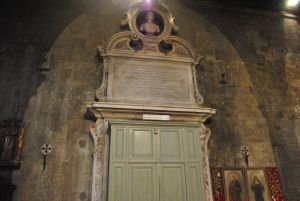 well deserved because thanks to a donation it took away the tithes to be paid as a tax from the people of Sanremo.
well deserved because thanks to a donation it took away the tithes to be paid as a tax from the people of Sanremo.
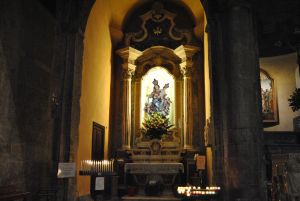 At the end of the left aisle there is a wooden statue of the Madonna del Rosario, sculpted between the sixteenth and eighteenth centuries under the influence of the great wooden works of Maragliano, by Giuseppe Compostano.
At the end of the left aisle there is a wooden statue of the Madonna del Rosario, sculpted between the sixteenth and eighteenth centuries under the influence of the great wooden works of Maragliano, by Giuseppe Compostano. 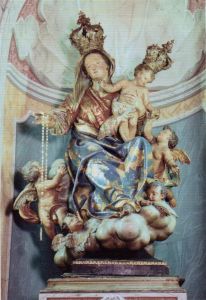 In 2018 the statue was completely restored by Raffaella Devalle who restored it to its ancient beauty. On the right wall of the altar there is a marble relief of the Virgin and Child Jesus, flanked by the patron saints of the city, St. Siro and St. Romolo, portrayed according to a compositional sensibility of late Gothic inspiration expressed with a particular majesty. Surely this artefact was part of a much more complex and important work and was probably the decoration of an entrance door.
In 2018 the statue was completely restored by Raffaella Devalle who restored it to its ancient beauty. On the right wall of the altar there is a marble relief of the Virgin and Child Jesus, flanked by the patron saints of the city, St. Siro and St. Romolo, portrayed according to a compositional sensibility of late Gothic inspiration expressed with a particular majesty. Surely this artefact was part of a much more complex and important work and was probably the decoration of an entrance door.
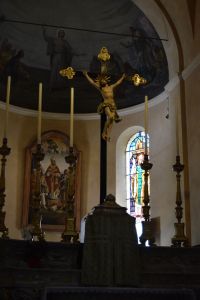 Above the 18th century high altar stands the great Christ Crucified in Agony, a wooden work attributed to Anton Maria Maragliano (1664-1739), the most famous wood sculptor active in Genoa between the 17th and 18th centuries. The Donetti company has provided for the complete restoration of the crucifix.
Above the 18th century high altar stands the great Christ Crucified in Agony, a wooden work attributed to Anton Maria Maragliano (1664-1739), the most famous wood sculptor active in Genoa between the 17th and 18th centuries. The Donetti company has provided for the complete restoration of the crucifix.
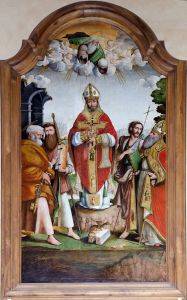 The choir altarpiece, dated 1548, was instead made by the Florentine Raffaele de Rossi, of whom we have news in a period between 1494 and 1572/73, and who was one of the major protagonists of Ligurian painting in the early sixteenth century. The work represents in the centre the figure of San Siro, flanked on the left by Saints Peter and Paul, and on the right by Saints John the Baptist and Romulus, saints who have a local Sanremo cult.
The choir altarpiece, dated 1548, was instead made by the Florentine Raffaele de Rossi, of whom we have news in a period between 1494 and 1572/73, and who was one of the major protagonists of Ligurian painting in the early sixteenth century. The work represents in the centre the figure of San Siro, flanked on the left by Saints Peter and Paul, and on the right by Saints John the Baptist and Romulus, saints who have a local Sanremo cult.
The panel has been interpreted as an express certificate of strict observance of Catholic dogma against the disruptive forces of the Lutheran reform movement. In particular, the initiative to have the painting executed was taken by the provost Stefano Gioffredo and the canons Girolamo Gaudo and Giuliano Ballestrero, who had presented themselves to the town council on 2 August 1534 to propose to the assembly to equip the collegiate church with an altarpiece worthy of the most important church in the city.
On 9 July, four years later, the Council entrusted its members Gio Antonio Rosso, Siretto Nicola, Pantaleone Fabiano and Raimondo Sapia with the task of assisting the San Siro Provost and the canons Gaudo and Ballestrero in conducting negotiations with Raffaele de Rossi, who, however, would not complete the work until ten years later. The altarpiece has recently undergone careful restoration by the Nicola Restauri laboratory in Aramengo d'Asti under the direction of Dr. Paola Traversone of the Superintendence for the Historical and Artistic Heritage of Liguria and the art historian Antonio Rolandi Ricci, who presented the results of the restoration on 13 March 2005.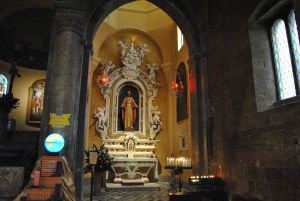 At the bottom of the right aisle is the altar of the Sacred Heart where we find on the external side the marble tabernacle with relief figures of the Angel,
At the bottom of the right aisle is the altar of the Sacred Heart where we find on the external side the marble tabernacle with relief figures of the Angel, 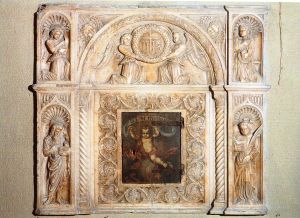 the Virgin, St. John the Baptist, St. Stephen and the Eucharistic monogram IHS. Marked by decorative elements from the Renaissance period that can be traced back to the Gagini's workshop style, the artefact can be dated to the end of the 15th century. In the altar before the reform of the Council of Trent, this tabernacle was supposed to guard the Eucharist, and was displayed together with the large wooden panel by Raffaello de Rossi. Later, with the works that saw the lengthening of the choir, this precious Renaissance artefact was placed in its present position and used as a custody for the holy oils.
the Virgin, St. John the Baptist, St. Stephen and the Eucharistic monogram IHS. Marked by decorative elements from the Renaissance period that can be traced back to the Gagini's workshop style, the artefact can be dated to the end of the 15th century. In the altar before the reform of the Council of Trent, this tabernacle was supposed to guard the Eucharist, and was displayed together with the large wooden panel by Raffaello de Rossi. Later, with the works that saw the lengthening of the choir, this precious Renaissance artefact was placed in its present position and used as a custody for the holy oils.
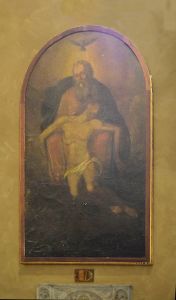 On the left wall of the altar there is also a canvas dating back to the eighteenth century and depicting the Holy Trinity, coming from the external aedicule called "of the Holy Spirit" which is located in the middle of via Debenedetti, the main street of the district. In this aedicule there is a copy of the painting which is not particularly precious.
On the left wall of the altar there is also a canvas dating back to the eighteenth century and depicting the Holy Trinity, coming from the external aedicule called "of the Holy Spirit" which is located in the middle of via Debenedetti, the main street of the district. In this aedicule there is a copy of the painting which is not particularly precious.
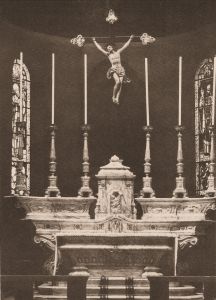 The altar of the Sacred Heart is characterised by Baroque decorations typical of the cult of the Blessed Sacrament.
The altar of the Sacred Heart is characterised by Baroque decorations typical of the cult of the Blessed Sacrament.
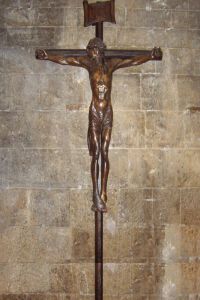 In the middle of the right aisle there is a large Crucifix commonly known as the "Black Christ" and already kept in the demolished oratory of San Germano in the altar specially built on a project by the painter Lorenzo Martini.
In the middle of the right aisle there is a large Crucifix commonly known as the "Black Christ" and already kept in the demolished oratory of San Germano in the altar specially built on a project by the painter Lorenzo Martini.
This precious artefact, dating back to the early 16th century, is linked to the Brotherhood of San Germano and has always been particularly venerated by the Matuzian faithful, who have always attributed to it the power to save the city from storms and drought.
The legend of Luca Spinola
6/7 August 1543 nine Algerian galleys with the reinforcement in the morning of other 6 ships, landed about a thousand armed men on the beaches of Sanremo attacking the city that was prepared for the defence and probably strong with an equal number of valid and armed men. Various sources report that the clash was very hard and engaged for eight hours the contenders, who were dead and wounded on both sides. The Algerians were unable to be right about the city, so they pretended to abandon it. Instead they landed on the east beach and headed for the valley of Verezzo, perhaps to bring a new attack behind them. During the move they plundered the countryside and kidnapped some women and their children, who could no longer be redeemed. The people of Sanremo, led by Luca Spinola, waited for the pirates in the Poggio Radino area and, after another violent clash at the Parà, near Verezzo, forced them to escape. The city was safe. These were the events, then the popular tradition says that before the battle Luca Spinola went to the oratory of San Germano and there he gathered on his knees in front of the black crucifix with the prayer of a "divine" support in order to win the battle against the dangerous enemy. After the favourable outcome for the people of San Remo, Luca Spinola returned in front of the crucifix to raise a prayer of thanksgiving for the favourable outcome of the battle, which from that day on turned out to be a historic date for the City.
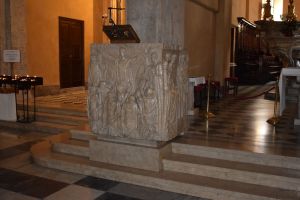 On 30th March 1952 the new ambo of the basilica was solemnly blessed with its balustrades made by the sculptor Dante Ruffini of Cremona. The ambo or pulpit, made from a single block of very hard marble, in the shape of a parallelepiped and with an antique ivory colour so as not to contrast with the material used for the erection of the church, is carved on three faces and there are various evangelical episodes in which the figure of Jesus always predominates.
On 30th March 1952 the new ambo of the basilica was solemnly blessed with its balustrades made by the sculptor Dante Ruffini of Cremona. The ambo or pulpit, made from a single block of very hard marble, in the shape of a parallelepiped and with an antique ivory colour so as not to contrast with the material used for the erection of the church, is carved on three faces and there are various evangelical episodes in which the figure of Jesus always predominates.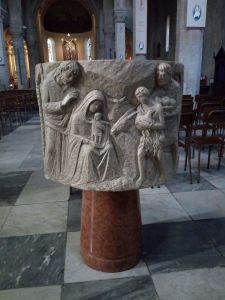 In 1960 Ruffini himself completed the three marble stoups, representing events from the Bible, which were placed at the entrances to the Co-cathedral.
In 1960 Ruffini himself completed the three marble stoups, representing events from the Bible, which were placed at the entrances to the Co-cathedral.
In 1992 the balustrades were removed and used for the decoration of the Eucharistic table for the people as required by the liturgical reform of Vatican II.


 In 1942 the artistic Via Crucis (Way of the Cross) was placed along the walls of the two side aisles, carved in lime wood by the Leghorn carver Cesare Tarrini, while six years later the Cremonese painter Giovanni Misani painted the great fresco above the choir and representing the scene of the Sermon on the Mount.
In 1942 the artistic Via Crucis (Way of the Cross) was placed along the walls of the two side aisles, carved in lime wood by the Leghorn carver Cesare Tarrini, while six years later the Cremonese painter Giovanni Misani painted the great fresco above the choir and representing the scene of the Sermon on the Mount.
(sources: text Ernesto Porri; images: personal and archive)





